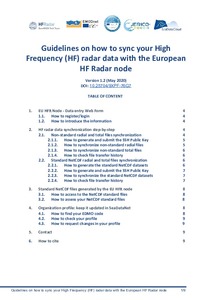Guidelines on how to sync your High Frequency (HF) radar data with the European HF Radar node (Version1.2).

View/
Average rating
votes
Date
2020Author
Reyes, E.
Rotllán-García, P.
Rubio, A.
Corgnati, L.
Mader, J.
Mantovani, C.
Status
PublishedPages
9pp.
Metadata
Show full item recordAbstract
This document is a step-by-step guide to start transferring HF radar (HFR) data from your
network to the EU HFR node .
The EU HFR node acts as the focal point for the European HFR data providers, implementing
the HF radar data flow from the data providers to the distribution platforms ( Copernicus
Marine Service , EMODnet-Phys and SeaDataNet )......
Resource URL
http://repository.socib.es/repository/entry/show?entryid=0f2ecac1-df43-43a3-a044-7e826e7167f5Publisher
Balearic Islands Coastal Observing and Forecasting System, SOCIBPalma de Mallorca, Spain
Document Language
enSustainable Development Goals (SDG)
14.AEssential Ocean Variables (EOV)
Surface currentsMaturity Level
TRL 9 Actual system "mission proven" through successful mission operations (ground or space)Best Practice Type
Best PracticeStandard Operating Procedure
Spatial Coverage
EuropeanDOI Original
10.25704/9XPF-76G7Citation
Reyes, E.; Rotllán-García, P.; Rubio, A.; Corgnati, L.; Mader, J.and Mantovani, C. (2019) Guidelines on how to sync your High Frequency (HF) radar data with the European HF Radar node (Version 1.2). Palma De Mallorca, Spain, Balearic Islands Coastal Observing and Forecasting System, SOCIB, 9pp. DOI: https://doi.org/10.25704/9XPF-76G7Collections
 Repository of community practices in Ocean Research, Applications and Data/Information Management
Repository of community practices in Ocean Research, Applications and Data/Information Management